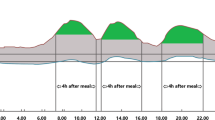Abstract
Background/Objectives:
Glycogen storage disease type I (GSD I) is an autosomal recessive metabolic disorder caused by defects in the glucose-6-phosphatase complex. Deficient activity in the glucose-6-phosphatase-α catalytic unit characterizes GSD Ia and defects in the glucose-6-phosphate transporter protein characterize GSD Ib. Type Ia involves the liver, kidney and intestine (and Ib also leukocytes), and the clinical manifestations are hepatomegaly, failure to thrive, severe fasting hypoglycemia within 3-4 h after a meal, hyperlactatemia, hyperuricemia and hyperlipidemia. The aim of the present study was to examine the safety and efficacy of a continuous subcutaneous glucose monitoring system to determine the magnitude and significance of hypoglycemia in GSD I and to evaluate the efficacy of the revised dietary treatment.
Subjects/Methods:
Sixteen children with GSD I were studied over a 72-h period. Continuous glucose monitoring (CGM) was repeated in all patients 3–6 months after the first monitoring to examine the effects of revised dietary instructions on glycemic control.
Results:
All the patients completed the study without any major adverse events. Significant periods of asymptomatic hypoglycemia (below 4 mmol/l, 70 mg/dl) were noted. There was a close correlation between CGM sensor and capillary blood glucose values measured by a glucometer. CGM indicated a considerable reduction in duration of hypoglycemia, liver size and improvements in secondary metabolic derangements such as hyperlacticacidemia and hyperlipidemia.
Conclusions:
CGM could be applied in the clinical setting to help the physician to identify hypoglycemic events, and repeated CGM may serve as a safe and useful tool for the assessment of the long-term management of patients with GSD I.
This is a preview of subscription content, access via your institution
Access options
Subscribe to this journal
Receive 12 print issues and online access
$259.00 per year
only $21.58 per issue
Buy this article
- Purchase on Springer Link
- Instant access to full article PDF
Prices may be subject to local taxes which are calculated during checkout






Similar content being viewed by others
References
Bhattacharya K . Dietary dilemmas in the management of glycogen storage disease type I. J Inherit Metab Dis 2011; 34: 621–629.
Chou JY, Jun HS, Mansfield BC . Glycogen storage disease type I and G6Pase-β deficiency: etiology and therapy. Nat Rev Endocrinol 2010; 6: 676–688.
Skyler JS . Intensive insulin therapy: a personal and historical perspective. Diabetes Educ 1989; 15: 33–39.
Diabetes Research in Children Network (DirecNet) Study Group. The accuracy of the Guardian RT continuous glucose monitor in children with type 1 diabetes. Diabetes Technol Ther 2008; 10: 266–272.
Hershkovitz E, Rachmel A, Ben-Zaken H, Phillip M . Continuous glucose monitoring in children with glycogen storage disease type I. J Inherit Metab Dis 2001; 24: 863–869.
Jadviscokova T, Fajkusova Z, Pallayova M, Luza J, Kuzmina G . Occurence of adverse events due to continuous glucose monitoring. Biomed Pap Med Fac Univ Palacky Olomouc Czech Repub 2007; 151: 263–266.
Mastrototaro J, Welsh JB, Lee S . Practical considerations in the use of real-time continuous glucose monitoring alerts. J Diabetes Sci Technol 2010; 4: 733–739. (Review).
Lagarde WH, Barrows FP, Davenport ML, Kang M, Guess HA, Çalikoglu AS . Continuous subcutaneous glucose monitoring in children with type 1 diabetes mellitus: a single-blind, randomized, controlled trial. Pediatr Diabetes 2006; 7: 159–164.
Maran A, Crepaldi C, Avogaro A, Catuogno S, Burlina A, Poscia A et al. Continuous glucose monitoring in conditions other than diabetes. Diabetes Metab Res Rev 2004; 20 (Suppl 2), S50–S55.
Mastrototaro J, Shin J, Marcus A, Sulur G . STAR 1 Clinical Trial Investigators. Clinical Trial Investigators. The accuracy and efficacy of real-time continuous glucose monitoring sensor in patients with type 1 diabetes. Diabetes Technol Ther 2008; 10: 385–390.
White FJ, Jones SA . The use of continuous glucose monitoring in the practical management of glycogen storage disorders. J Inherit Metab Dis 2011; 34: 631–642.
Radermecker RP, Saint Remy A, Scheen AJ, Bringer J, Renard E . Continuous glucose monitoring reduces both hypoglycaemia and HbA1c in hypoglycaemia-prone type 1 diabetic patients treated with a portable pump. Diabetes Metab 2010; 36: 409–413.
Ulf S, Ragnar H, Arne WP, Johnny L . Do high blood glucose peaks contribute to higher HbA1c? Results from repeated continuous glucose measurements in children. World J Pediatr 2008; 4: 215–221.
Keenan DB, Cartaya R, Mastrototaro JJ . Accuracy of a new real-time continuous glucose monitoring algorithm. J Diabetes Sci Technol 2010; 4: 111–118.
Battelino T, Bolinder J . Clinical use of real-time continuous glucose monitoring. Curr Diabetes Rev 2008; 4: 218–222. (Review).
Author information
Authors and Affiliations
Corresponding author
Ethics declarations
Competing interests
The authors declare no conflict of interest.
Rights and permissions
About this article
Cite this article
Kasapkara, Ç., Cinasal Demir, G., Hasanoğlu, A. et al. Continuous glucose monitoring in children with glycogen storage disease type I. Eur J Clin Nutr 68, 101–105 (2014). https://doi.org/10.1038/ejcn.2013.186
Received:
Accepted:
Published:
Issue Date:
DOI: https://doi.org/10.1038/ejcn.2013.186
Keywords
This article is cited by
-
A preliminary study of telemedicine for patients with hepatic glycogen storage disease and their healthcare providers: from bedside to home site monitoring
Journal of Inherited Metabolic Disease (2018)
-
Role of continuous glucose monitoring in the management of glycogen storage disorders
Journal of Inherited Metabolic Disease (2018)
-
The association of early combined lactate and glucose levels with subsequent renal and liver dysfunction and hospital mortality in critically ill patients
Critical Care (2017)
-
Alternative nighttime nutrition regimens in glycogen storage disease type I: a controlled crossover study
Journal of Inherited Metabolic Disease (2015)
-
Lipids in hepatic glycogen storage diseases: pathophysiology, monitoring of dietary management and future directions
Journal of Inherited Metabolic Disease (2015)



